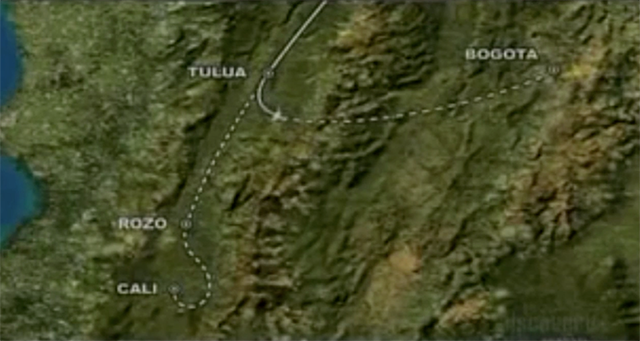That the pilots made multiple errors of procedure and judgement is without a doubt. The most alarming fact, however, was their lack of situational awareness. Knowing they are flying into a valley in mountainous terrain argues for a very deliberate approach to getting the FMS programmed and heightened awareness of distance from the airport.
— James Albright

Updated:
2012-10-15
Of course this mishap shocked the airline world; these were highly qualified pilots flying state-of-the-art equipment for a very good air carrier. Much of the standardized procedure that came out certainly existed before. But now it was reinforced with an example of how wrong things can get when you ignore this kind of flight discipline.

1
Accident report
- Date: 20 DEC 1995
- Time 21:38:
- Type: Boeing 757-223
- Operator: American Airlines
- Registration: N651AA
- Fatalities: 8 of 8 crew, 159 of 163 passengers
- Aircraft Fate: Destroyed
- Phase: Approach
- Airport: (Departure) Miami International Airport, FL (MIA/KMIA), United States of America
- Airport: (Destination) Cali-Alfonso Bonilla Aragón Airport (CLO/SKCL), Colombia
2
Narrative
At about 18:34 EST, American Airlines Flight 965 took off from Miami for a flight to Cali. At 21:34, while descending to FL 200, the crew contacted Cali Approach.
The aircraft was 63nm out of Cali VOR (which is 8nm South of the airport)) at the time. Cali cleared the flight for a direct Cali VOR approach and report at Tulua VOR. Followed one minute later by a clearance for a straight in VOR DME approach to runway 19 (the Rozo 1 arrival).
The crew then tried to select the Rozo NDB (Non Directional Beacon) on the Flight Management Computer (FMC). Because their Jeppesen approach plates showed 'R' as the code for Rozo, the crew selected this option. But 'R' in the FMC database meant Romeo. Romeo is a navaid 150nm from Rozo, but has the same frequency. The aircraft had just passed Tulua VOR when it started a turn to the left (towards Romeo). This turn caused some confusion in the cockpit since Rozo 1 was to be a straight in approach. 87 Seconds after commencing the turn, the crew activated Heading Select (HDG SEL), which disengaged LNAV and started a right turn. The left turn brought the B757 over mountainous terrain, so a Ground Proximity (GPWS) warning sounded. With increased engine power and nose-up the crew tried to climb. The spoilers were still activated however. The stick shaker then activated and the aircraft crashed into a mountain at about 8900 feet (Cali field elevation being 3153 feet).
4
Cause
- The flight crew's failure to adequately plan and execute the approach to runway 19 at SKCL and their inadequate use of automation;
- Failure of the flight crew to discontinue the approach into Cali, despite numerous cues alerting them of the inadvisability of continuing the approach;
- The lack of situational awareness of the flight crew regarding vertical navigation, proximity to terrain, and the relative location of critical radio aids;
- Failure of the flight crew to revert to basic radio navigation at the time when the FMS-assisted navigation became confusing and demanded an excessive workload in a critical phase of the flight.
- The flight crew's ongoing efforts to expedite their approach and landing in order to avoid potential delays;
- The flight crew's execution of the GPWS escape manoeuvre while the speed brakes remained deployed;
- FMS logic that dropped all intermediate fixes from the display(s) in the event of execution of a direct routing;
- FMS-generated navigational information that used a different naming convention from that published in navigational charts.
5
Postscript
This mishap shocked the airline world; these were highly qualified pilots flying state-of-the-art equipment for a very good air carrier. Much of the standardized procedure that came out certainly existed before. But now it was reinforced with an example of how wrong things can get when you ignore this kind of flight discipline:
- When asked to report a waypoint, immediately identify it and discuss the time remaining to that waypoint. (These pilots were passing the waypoint when asked for the report and never did identify it when repeatedly asked to report it.)
- When directing the FMS to go to a new waypoint, both pilots should confirm the airplane will head where intended before allowing it to command the turn. (The captain inserted the wrong waypoint which turned the airplane sharply away from course. Both pilots could have seen this on their navigation displays in time to correct the situation.)
- When considering a last minute change, ensure you are caught up with the airplane. (Both pilots were still confused with the approach they had previously briefed, agreeing to change to a straight-in gave them even less time to catch up.)
- When using the speed brakes, keep your hand on the handle as a reminder to retract them. (The first officer extended them and never retracted them, even during the CFIT escape maneuver.)
- When lost: climb and communicate. (The crew elected to head direct to the airport, not knowing they had flown into an adjacent valley and had a mountain range between them and the airport.)
References
(Source material)
Colombia Aeronautica Civil, Controlled Flight Into Terrain, American Airlines Flight 965, Boeing 757-223, N651AA, Near Cali, Colombia, December 20, 1995 (Prepared by University of Bielefeld, Germany
Flight Safety Foundation, "Boeing 757 CFIT Accident at Cali, Columbia, Becomes Focus of Lessons Learned," Flight Safety Digest, May-June 1998
Mayday: Lost, Cineflix, Episode 4, Season 2, 20 February 2005 (American Airlines 965)

